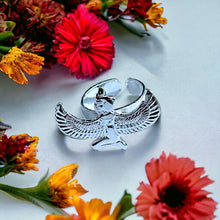The Goddess Maat Adjustable Silver Ring pays homage to Ma'at, the ancient Egyptian deity of truth, balance, and justice. Crafted with intricate details, this ring embodies the timeless elegance of Egyptian culture while offering adjustable sizing for modern comfort and style.
- History: Inspired by ancient Egyptian culture, symbolizing balance and justice.
- Spiritually: Represents harmony, truth, and order in one's life.
- Talisman: A potent symbol of protection and guidance.
- Handmade: Crafted with care and attention to detail by skilled artisans.
- Healing: Believed to promote inner balance and alignment.
- Material: Made of sterling silver, a metal associated with purity and clarity.
- Symbolism: The ring features Maat, the goddess of truth and justice, embodying ethical principles.
- How to Wear: Adjustable design for versatile styling, worn to channel Maat's energy and virtues.
History Side For Those Who Are Interested
Maat, the ancient Egyptian goddess of truth, balance, order, law, morality, and justice, holds a significant place in the pantheon of Egyptian deities. Her origins trace back to the earliest periods of Egyptian civilization, with her worship extending throughout the entirety of ancient Egyptian history.
The concept of Maat, represented by the hieroglyphic symbol of an ostrich feather, embodies the fundamental principles of harmony and balance that were essential to Egyptian society's functioning. Maat was believed to be the daughter of the sun god Ra, emerging from his primordial creation. As such, she was closely associated with cosmic order and the divine law that governed the universe.
Maat's role was multifaceted and integral to Egyptian life. She ensured that the forces of chaos, symbolized by the god Set, were kept in check, allowing for the continuation of creation and the stability of society. Maat was also the patron of truth and justice, presiding over the weighing of the deceased's heart against her feather of truth in the afterlife judgment scene depicted in the Book of the Dead. If the heart was found to be lighter than the feather, the individual was deemed worthy of entering the blissful afterlife; however, if the heart was heavy with wrongdoing, it would be devoured by the monstrous creature Ammit.
In addition to her cosmic and judicial roles, Maat's influence extended to earthly matters. She personified the moral and ethical standards that governed Egyptian society, guiding individuals in their interactions with one another and emphasizing the importance of honesty, integrity, and fairness. Maat was invoked in legal proceedings, ensuring that judgments were just and equitable.
Depicted as a woman wearing a crown with an ostrich feather, often holding a scepter and ankh, Maat's image adorned temples, tombs, and monuments throughout Egypt. She was frequently depicted alongside the pharaoh, symbolizing the ruler's adherence to Maat's principles in governing the kingdom.
The concept of Maat was not confined to religious beliefs but permeated all aspects of Egyptian culture, influencing art, literature, and philosophy. The pursuit of Maat was seen as the highest ideal, guiding individuals in their quest for enlightenment and moral perfection.
Despite the political and religious changes that occurred throughout Egyptian history, the reverence for Maat remained constant, illustrating her enduring significance in the Egyptian worldview. Even with the decline of ancient Egyptian civilization, the legacy of Maat endured, her principles continuing to inspire and influence generations beyond her time.








